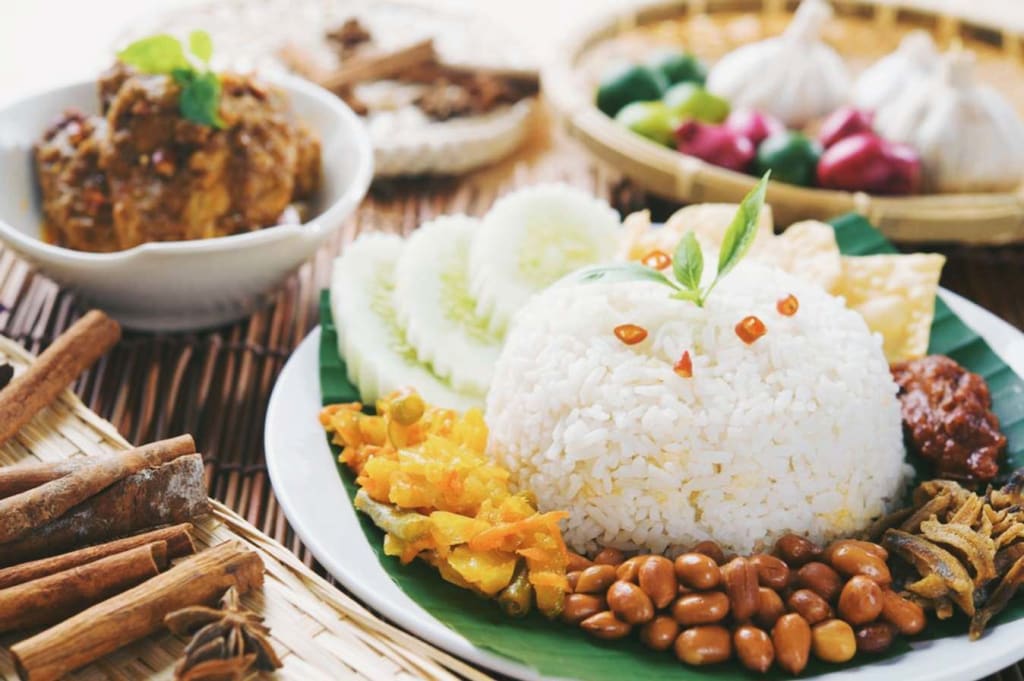
Malaysia, a treasure in Southeast Asia, has a diverse and vibrant cuisine that reflects its rich cultural tapestry. A melting pot of Malay, Chinese, Indian, and indigenous culinary traditions, this gastronomic paradise offers an unparalleled combination of flavors, textures, and aromas. Malaysian cuisine is one of the world's most exciting culinary destinations because it reflects the country's history, geography, and multicultural population. The origins, ingredients, and cultural significance of the various Malaysian dishes are examined in this article.
1.Nasi Lemak:The Signature Dish of Malaysia Nasi lemak, which is frequently regarded as the national dish of Malaysia, exemplifies the essence of Malaysian cuisine. Traditionally, this dish consists of rice cooked in coconut milk and served with anchovies, peanuts, a boiled egg, cucumber, and sambal, a spicy chili paste. The aroma of the pandan leaves-infused rice sets the stage for an exciting and reassuring culinary experience. Nasi lemak has its roots in Malay culture, where it was originally a meal for farmers to fuel them for the day's work. It has developed over time and is now widely available throughout Malaysia in both high-end restaurants and roadside stalls. Additional accompaniments include fried chicken, rendang—a slow-cooked dry curry—or sambal sotong—spicy squid—in nasi lemak variations.
2.Skewed Delight: Satay Another well-known Malaysian dish is satay, which is made by grilling marinated meat skewers to perfection over an open flame. Satay is a popular dish at night markets and food courts all over the country. It comes with rice cakes (ketupat), peanut sauce, and a simple salad of onions and cucumbers. Even though satay is popular all over Southeast Asia, Malaysian satay is different because of how it uses spices and how thick the peanut sauce is. The meat, which is typically beef or chicken, is marinated in a mixture of turmeric, lemongrass, and other spices. This gives the meat a distinct flavor that is both savory and slightly sweet. The charred meat is perfectly complemented by the creamy peanut sauce, making each bite a delightful flavor explosion.
3.Royal Street Food: Char Kway Teow The beloved street food dish char kway teow is an example of the Chinese influence on Malaysian cuisine. Flat rice noodles, prawns, Chinese sausage, eggs, bean sprouts, and chives are all cooked in a smoky wok with a mixture of soy sauce and chili paste to make this stir-fried noodle dish. The wok hei, or "breath of the wok," which gives the noodles their distinctive smoky flavor, is the key to a great char kway teow. This is accomplished by cooking the dish at a very high temperature, allowing the ingredients to caramelize and develop a complex and satisfying depth of flavor. Locals and tourists alike adore char kway teow, which is typically served with pickled green chilies and a squeeze of lime.
4.The flaky flatbread known as roti canai Malaysians have adopted roti canai, a popular Indian-inspired breakfast dish. This buttery, flaky flatbread is a versatile and filling meal that goes well with dhal (lentil curry) or other currys. Roti canai is made by repeatedly folding and stretching the dough to form multiple layers, which requires skillful preparation. The dough puffs up as it cooks on a hot griddle, making the bread crispy on the outside and soft on the inside. There are both savory and sweet versions of roti canai, both of which are stuffed with meat, cheese, or eggs, and are filled with condensed milk or bananas.
5.Laksa: A Warming Bowl Laksa is a spicy noodle soup that can be made in a variety of regional ways, each one reflecting the ingredients and culinary practices of that region. Penang Assam Laksa and Laksa Lemak are the two most well-known varieties of laksa in Malaysia. The fish-based broth of Penang Assam Laksa, which comes from the island of Penang, is tangy and spicy. Thick rice noodles, mackerel, cucumber, pineapple, and mint leaves are typically accompanied by the sour soup, which is typically made with tamarind. It is a favorite among people who like their food to have a little bit of heat and acidity. The flavors are strong and refreshing. On the other hand, the broth in Laksa Lemak is made with coconut milk and is thick and creamy. This version has a flavor that is reassuring and slightly sweet, with less tang and more indulgence. It usually has rice noodles, chicken, prawns, tofu puffs, hard-boiled eggs, and lime and fresh herbs on top. Laksa is a popular dish in Malaysia because it has a harmonious combination of flavors and textures in every spoonful.
6.Hainanese Chicken Rice:The Ultimate in Simplicity One Malaysian dish that exemplifies the beauty of simplicity is the hainanese chicken rice. A trio of sauces—garlic-chili, ginger, and soy—are served alongside poached chicken and fragrant rice cooked in chicken broth in this Chinese-inspired dish. The rice is flavorful and aromatic, infused with the essence of chicken fat and aromatics like ginger and garlic, while the chicken is cooked to perfection and is tender and juicy. Diners are able to personalize each bite according to their preferences thanks to the sauces, which add an additional layer of flavor. The fact that simple, well-executed ingredients can result in a dish that is both filling and delicious is demonstrated by the Hainanese chicken rice.
7.Rendang:The Spicy Soup Rendang is a dry, slow-cooked curry that comes from Indonesia's Minangkabau ethnic group but has been embraced by Malaysians wholeheartedly. Beef is used to make this dish, but chicken and lamb can also be used. It is simmered for hours in a rich mixture of coconut milk and spices like chili, galangal, lemongrass, garlic, turmeric, ginger, and ginger. The end product is a stew with a lot of flavor and tender meat that melts in your mouth. The spices are able to penetrate the meat during the slow cooking process, resulting in a complex and aromatic dish that is typically reserved for special occasions and celebrations. Rendang is a spicy dish that goes well with rice or nasi lemak because of its strong flavors. People who like hearty, spicy dishes like this one.
8.Cendol:A Delicious Treat Cendol is a popular dessert in Malaysia that provides a cooling break from the heat of the tropical climate. Shaved ice, coconut milk, and palm sugar syrup are the toppings on this delicious dessert. Red beans, sweet corn, and grass jelly are examples of additional ingredients that can be included. Cendol's delightful combination of flavors and textures is what makes it so appealing. The chewy jelly and the crunchy ice stand out against the smooth, creamy coconut milk, and the palm sugar syrup adds a rich, caramel-like sweetness. Cendol, a well-liked dessert that can be found in abundance at food courts and street stalls, is a refreshing way to end a meal.
9.The Pulled Tea, or Teh Tarik Teh tarik, the national drink, must be mentioned in any discussion of Malaysian cuisine. A strong tea that has been combined with condensed milk and "pulled" to form a frothy top is known as teh tarik, which translates to "pulled tea." Tea is poured back and forth between two containers from a height during the pulling process, which not only cools the tea to the ideal drinking temperature but also aerates it, giving it a creamy texture. Teh tarik is a popular breakfast dish that can be enjoyed at any time of the day. It is a beverage that is deeply ingrained in Malaysian culture due to its comforting and indulgent flavor.
10.The Delight of Blue Rice, Nasi Kerabu The state of Kelantan is home to the stunningly beautiful dish known as nasi kerabu. Served with grilled fish or chicken, salted eggs, pickles, and a variety of fresh herbs and vegetables, the blue-tinted rice is accompanied by a variety of other items. In addition to being visually appealing, the blue rice has a subtle flavor that is frequently enhanced with herbs and coconut milk. Nasi kerabu is a dish that is both complex and filling due to the combination of textures and flavors, from the savory protein to the tangy pickles and aromatic herbs. It exemplifies how Malaysian cuisine can showcase the country's extensive cultural heritage while also being delicious.
In the end Each dish in Malaysian cuisine tells a story about the country's diverse cultural heritage and offers a delightful combination of flavors, textures, and aromas. Every meal in Malaysia is an opportunity to experience the country's distinctive culinary traditions, which range from the nourishing nasi lemak and the savory satay to the vibrant char kway teow and the indulgent rendang. The impact of Malay, Chinese, Indian, and native culinary practices is obvious in the assortment and intricacy of Malaysian food. The use of fresh, high-quality ingredients and a deep appreciation for the art of cooking are the common threads whether you're savoring the rich flavors of laksa or a straightforward bowl of Hainanese chicken rice. Food is more than just food in Malaysia; it's a way of life, a way to connect people and celebrate the country's diverse cultural heritage. Each dish demonstrates the culinary prowess and originality of Malaysian cooks, who have perfected the technique of combining a variety of flavors and textures to produce delectable and memorable meals. Every bite of Malaysian cuisine, which offers new and exciting flavors that reflect the heart and soul, is a journey that you'll discover as you explore the vibrant world.
About the Creator
Ovijit paul
I am a food blogger and I blog about popular foods from different countries. Hope you like my writings.






Comments
There are no comments for this story
Be the first to respond and start the conversation.